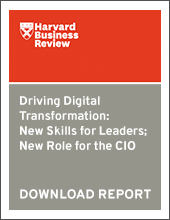CIOs have a powerful opportunity to lead their organizations in digital fluency, according to a recent report by Harvard Business Review Analytic Services. When they do, their organizations are more likely to see tangible business results, such as increased revenue growth and profit margins. Those organizations that are leading the way are identified in the report as "Digital Leaders," yet less than a fifth of respondents (19 percent) fell into that category.

Digital Leaders, the report says, are organizations that have both a compelling digital vision as well as the people, processes and technology needed to execute against that vision.
Digital Leaders do a number of things that other companies can learn from. Given that more than 80 percent of respondents are either Followers or Laggards, there’s plenty of room for improvement. CEOs should personally lead this charge from a vision and strategy perspective, going on the road and sharing the message with leaders in all markets. And there’s a lot that CIOs, often in partnership with other company leaders, can do as well.
1. Create a digital advisory board with both internal and outside experts to advise the executive team.
2. Learn to paint a picture of the digital future, and use examples from companies in similar industries to make that real.
3. Embed IT staff in the lines of business so that learning happens during the course of work, not just in special meetings or training sessions.
4. Create a common lexicon to increase understanding, communicating in language that makes sense from the perspective of business activities and outcomes, not IT. It helps to start from the customer’s perspective.
5. Partner closely with key business leaders—especially the CMO and the head of product development—to bring together the best from both domains. Identify and make clear which digital knowledge and skills need to reside in the lines of business and which should reside in IT.
6. Work with the training and development organization to establish both formal and informal learning forums.
7. Embrace a coaching framework across the organization, with KPIs built into individual managers’ performance reviews.
8. Identify and bring in outside experts to address specific trends for different parts of the business.
Download the full report and learn why digital acumen is becoming an important differentiator.




